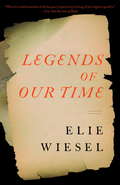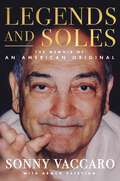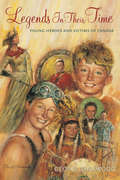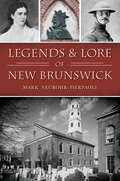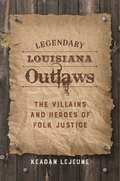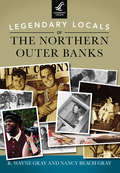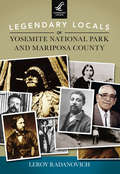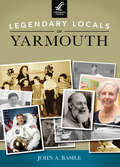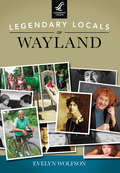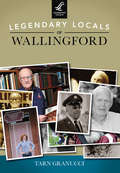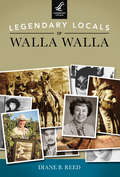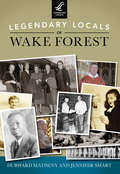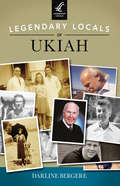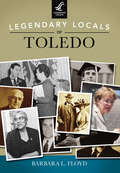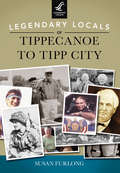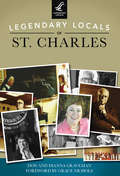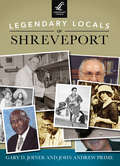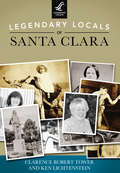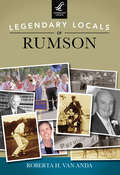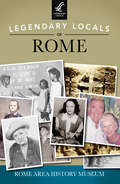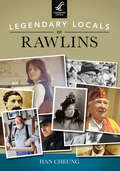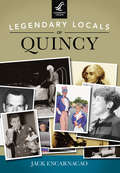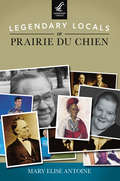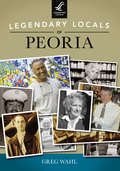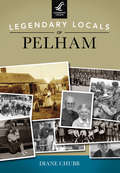- Table View
- List View
Legends of Our Time
by Elie WieselA collection of tales immortalizing the heroic deeds and visions of people Wiesel knew during and after World War II.From the Trade Paperback edition.
Legends and Soles: The Memoir of an American Original
by Armen Keteyian Sonny VaccaroThe gripping and eye-opening memoir from the “Savior of Nike” and the man who discovered Michael Jordan, Sonny Vaccaro.Written in collaboration with six-time New York Times bestselling author Armen Keteyian, Legends and Soles provides context and truth to the sensational media stories and headlines, including:Vaccaro’s pivotal role in the never-before-told story of the courting and signing of Michael JordanHow Nike, at the behest of an embittered Knight, went as far as having the Portland FBI investigate Vaccaro who was working for archrival Adidas on a RICO charge of corporate espionageHis close relationships with NBA superstars Kobe Bryant, LeBron James, Kevin Garnett, and Tracy McGrady, and Hall of Fame coaches Jerry Tarkanian of UNLV and John Thompson of GeorgetownThe high stakes drama behind the O’Bannon lawsuit that changed the entire landscape in college sportsFilled with in-depth stories and sixteen pages of photos illuminating some of Sonny’s most treasured career memories, Legends and Soles is the long-awaited memoir of a giant of American sports.
Legends In Their Time: Young Heroes and Victims of Canada
by George Sherwood Stewart SherwoodA remarkable cast of past and present young Canadians stride across the pages of Legends In Their Time, each having a significant role to play in Canadian history. Beginning in the 1500s and moving on into the 20th century, each chapter contributes insights into the evolution of Canada as a nation.Author George Sherwood’s thorough research and his scene setting bring to life the heroic accomplishments and tragic exploits that make Canada’s story a fascinating and entertaining account. Included are explorer Etienne Brule; Osborne Anderson, survivor of Harper’s Ferry; inventor Armand Bombardier; human rights activist Toy Jin "Jean" Wong; and the heroic Terry Fox, to name but a few of the extraordinary lives that are chronicled. Complementing the text are historic photographs and original artwork by award-winning artist Stewart Sherwood."For those who think Canada lacks heroes or Canada does not honour its heroes, Legends In Their Time is the book for you. Extensively researched and written in an engaging style, it recognizes that heroes and heroines come in many forms, as shown in the richness of our history.”- John Myers, Teacher Educator, OISE/UT
Legends & Lore of New Brunswick (Narrative)
by Mark Neurohr-PierpaoliFolktales, hidden treasures and witchcraft. The towering skyline of New Brunswick stands in stark contrast with the swampy ceder forest it emerged from in the late 1600s. While the city grew over the original Lenape settlement of Ahanderamock, its history was passed on through whispers of tales both real and imagined. In the Buccleuch Mansion, a skeletal figure dressed as a British Grenadier is said to stagger the halls with a lantern, and at Rutgers University tales of secret societies swirl through campus. Long-lost pirate treasures, some rumored to be connected to mysterious clues etched in stone, remain undiscovered to this day. Author Mark Neurohr-Pierpaoli uncovers the mysterious stories lurking below the surface of New Brunswick.
Legendary Louisiana Outlaws: The Villains and Heroes of Folk Justice
by Keagan LejeuneFrom the infamous pirate Jean Laffite and the storied couple Bonnie and Clyde, to less familiar bandits like train-robber Eugene Bunch and suspected murderer Leather Britches Smith, Legendary Louisiana Outlaws explores Louisiana's most fascinating fugitives. In this entertaining volume, Keagan LeJeune draws from historical accounts and current folklore to examine the specific moments and legal climate that spawned these memorable characters. He shows how Laffite embodied Louisiana's shift from an entrenched French and Spanish legal system to an American one, and relates how the notorious groups like the West and Kimbrell Clan served as community leaders and law officers but covertly preyed on Louisiana's Neutral Strip residents until citizens took the law into their own hands. Likewise, the bootlegging Dunn brothers in Vinton, he explains, demonstrate folk justice's distinction between an acceptable criminal act (operating an illegal moonshine still) and an unacceptable one (cold-blooded murder). Recounting each outlaw's life, LeJeune also considers their motives for breaking the law as well as their attempts at evading capture. Running from authorities and trying to escape imprisonment or even death, these men and women often relied on the support of ordinary citizens, sympathetic in the face of oppressive and unfair laws. Through the lens of folk life, LeJeune's engaging narrative demonstrates how a justice system functions and changes and highlights Louisiana's particular challenges in adapting a system of law and order to work for everyone.
Legendary Locals of the Northern Outer Banks
by R. Wayne Gray Nancy Beach GrayThe remoteness and isolation of North Carolina's northern Outer Banks has shaped both early settlers and relative newcomers into tough and independent souls. Sir Walter Raleigh's colonists may have mysteriously disappeared from Roanoke Island, but the enterprising homesteaders who followed managed to eke out a living on the windswept and battered banks. Entrepreneur E.R. Daniels ran a line of mail and freight boats that helped connect the Outer Banks to the outside world. Former slave and Civil War hero Richard Etheridge did not shirk from an opportunity to become the first black keeper of a lifesaving station. In the mid-20th century, leaders like Bradford Fearing saw the importance of developing tourism, so that people would come see Paul Green's new outdoor drama, The Lost Colony. Outer Bankers have warmly welcomed visitors, from the time the Wright brothers arrived to today's modern tourists. The challenge now is to balance commercial growth with environmental sensibility so that oystermen, like Georgie Daniels, and fishermen, like Dewey Hemilwright, can continue to ply the waters.
Legendary Locals of Yosemite National Park and Mariposa County (Legendary Locals)
by Leroy RadanovichIn 1846, Thomas Larkin, American council general to the Mexican government in California, purchased a Mexican land grant, Las Mariposas, for Col. John C. Fremont. The grant consisted of 10 square leagues of grazing land located near the Merced River and west of the Sierra. In 1848, when California became the possession of the United States, the treaty called for the recognition of preexisting grants. Gold was discovered in the foothills of the Sierra that same year. Fremont floated his questionable Mexican grant into the gold discovery region. With the formation of the State of California in 1850, one of the original counties was named Mariposa, Spanish for "butterflies." Located within the county was the Fremont grant and much of the yet undiscovered Yosemite region of the Sierra. Encounters with Native Americans near the mining camps lead to the formation of the Mariposa Battalion, and a search for the natives led to the American discovery of Yosemite Valley. Thus, it was custodians and photographers such as Charles Leander Weed, Carlton E Watkins, J.J. Riley, George Fiske, Ansel Adams, and many others that interpreted and introduced Yosemite to the world.
Legendary Locals of Yarmouth
by John A. BasileWith roots as deep as the earliest years of the American colonies, Yarmouth has a long and colorful history that is still being written. When Stephen Hopkins built his home with permission from the court of Plymouth Colony, Yarmouth was already home to native peoples. Bounded on its north and south sides by the Atlantic Ocean, it is no surprise that ship captains, salt makers, and merchants are part of the town's early history. Later, artists, writers, and educators also became part of the scene. The artist Edward Gorey chose Yarmouth for his home, as did astronaut Daniel Burbank. Jazzman Lou Colombo and town administrator Robert Lawton have also made their marks on the community. Yarmouth's distinct neighborhoods are a source of pride, and historic preservation is a prime concern to many. The town's annual October gathering is called the Seaside Festival, to let one and all know that the people of Yarmouth are very much aware of their connection to the Atlantic.
Legendary Locals of Wayland
by Evelyn WolfsonWayland's historic district is dominated by the 1815 First Parish Church, designed and built by Andrews Palmer of Newburyport, who adapted an Asher Benjamin design. The Rev. Edmund Sears served as minister for 17 years and wrote "It Came Upon the Midnight Clear" for a First Parish Sunday school celebration in 1849. Wealthy Bostonians soon established summer homes in town. Willard Austin Bullard purchased the residence beside the church and christened it Kirkside, and William Power Perkins purchased Mainstone Farm and established the first Guernsey cow farm in the state. By the mid- to late 1800s, Cochituate Village was dominated by a well-established shoe industry and stately Victorian homes lined the streets. A little more than a century later, the town was preparing for an influx of folks from the city. Howard Russell and Allen Benjamin created an official town map, designating streets, and delineating the established uses for the town's 15.2 square miles. Thanks to the vision and hard work of these men and others like them, the town still retains a semblance of its rural atmosphere with almost 3,000 acres of permanently protected open space.
Legendary Locals of Wallingford
by Tarn T. GranucciLegendary Locals of Wallingford is about fabric--the fabric of community that is made up of an amazing variety of threads, yarns, and whole panels of every color, design, and origin. These represent the people of the community. Wallingford's story goes back over 350 years and encompasses an enormous range of people with every kind of motivation for being part of this town. The people of this community love where they live and give back to the townspeople who have supported their businesses, educated their children, and protected them in so many ways. Wallingford has produced a number of people of celebrity, including Morton Downey, the famous singer and songwriter of the 1920s and 1930s, and also his son Morton Downey Jr., who earned a name for himself in the TV talk show world; Beverly Donofrio authored Riding in Cars With Boys; Maureen Moore acts on Broadway; sculptor Robert Gober recently completed a major show at MOMA in New York; and Maj. Raoul Lufbery was a renowned World War I Flying Ace. These and more are celebrated here.
Legendary Locals of Walla Walla
by Diane B. ReedNestled in the foothills of southeastern Washington's Blue Mountains, Walla Walla has been a center of commerce and culture since its founding in 1862. Earlier, the Walla Walla River Valley was the site of Indian rendezvous, Marcus and Narcissa Whitman's mission, and British and American forts and trading posts. The new city prospered as an outfitting center for nearby Idaho goldfields. Capt. John Mullan's military road provided a route for miners and new settlers coming to the valley. Merchants like the Schwabacher Brothers and bankers Dorsey Syng Baker and John Boyer tapped into the city's growth, which expanded as wheat became the new gold. Home to Fort Walla Walla, the city welcomed Whitman College, Walla Walla University, and the territorial penitentiary. Today, the revitalized downtown and burgeoning culinary and arts scene are popular tourist destinations. Walla Walla sweet onions are nationally known, and more than 120 wineries call the valley home, from Figgins family's pioneer Leonetti Cellar (1977) to football legend Drew Bledsoe's Doubleback winery.
Legendary Locals of Wake Forest
by Jennifer Smart Durward MathenyFor much of its history, Wake Forest was an idyllic college town. Trains chugged past White Street, the depot hummed with activity, and citizens could shop for groceries, see a movie, and cheer the Demon Deacons without ever getting behind the wheel of a car. It was a town of visionaries. Samuel Wait, William Louis Poteat, Sophie Stephens Lanneau, and Peahead Walker made history in the fields of academics, religion, and athletics; when famous 20th-century writer and satirist H.L. Mencken reportedly called North Carolina "the most intelligent" of all Southern states, he was referring to Wake Forest. That tradition continues today. The Allen family publishes one of the region's most honored weekly newspapers; Andy Ammons recreated small-town magic in the community known as Heritage Wake Forest; and Steve Tarangelo followed his dream to prove that "food is love."
Legendary Locals of Ukiah (Legendary Locals)
by Darline BergereMountains. Trees. A lake. What makes a city, town, or village come to life are the people--those who have gone before and those who are there today. They are what shape and build the community of Ukiah. With their personalities, foibles, compassion, and humor, some of these influential men and women stand out by design and some quietly exist on the sidelines. Utah Haley, a disabled veteran, drives other veterans to doctors' appointments. Rick Paige is always the first on-scene to help in a disaster. Spencer Brewer started the "Sundays in the Park" free concerts more than two decades ago. Ukiah is a town that supports its businesses, and those same local businesses give back to the community in many ways. Shannon Riley of Shoefly and Sox holds an annual shoe drive. Jan Hoyman and Doug Browe of Hoyman Browe Studios donate countless pieces of their work to charitable auctions. Ann Kilkenny of Mendocino Book Company gives time and assistance to local organizations. Marty Lombardi, who spent 40 years with Savings Bank of Mendocino, was always lending a helping hand to local nonprofits.
Legendary Locals of Toledo (Legendary Locals)
by Barbara L. FloydWhile Jesup W. Scott proclaimed it the "Future Great City of the World" in 1868, in reality, Toledo saw little development for the first four decades after its founding in 1837. Plagued by swamps, disease, and unwelcoming occupants, few settled here. But slowly, the city attracted people who saw a chance to improve their lives and perhaps their fortunes, including Edward Drummond Libbey. In 1888, Libbey brought with him the glass industry that would dominate the city's economy and earn it the nickname of "Glass Capital of the World." Legendary Locals of Toledo describes the impact of people like Scott, Libbey, and others who shaped Toledo--from the well known whose names grace street signs, buildings, and monuments, to unsung heroes who few remember. Included are pioneers who were the first in their fields as well as leaders of business and industry, representatives of government and the law, and successful entertainers and sports figures. Some were born here and moved on to make their impact, while others lived here and impacted the city.
Legendary Locals of Tippecanoe to Tipp City
by Susan FurlongLock No. 15 on the Miami and Erie Canal ensured the development of Tippecanoe, Ohio, but the village would not have grown into the busy Tipp City of today without people determined to build futures for themselves and their families. John Clark established the town, and prosperity came with men and women like Joshua Horton and his newspaper, John Garver and his furniture factory, James Scheip of Tipp Novelty, Peter Bohlender of SpringHill Nursery, and the Timmers of TipTop Canning. The strong school system evolved thanks to innovative leaders like James Bartmess and L.T. Ball. The entire community benefited from the vision of Sidney Chaffee and his opera house, and it benefits still today with the visions of volunteers like Bob and Jackie Wahl and Peg Hadden, who, along with so many others, give their time, talent, and love to Tippecanoe and Tipp City.
Legendary Locals of St. Charles (Legendary Locals)
by Grace Nichols Don Graveman Dianna GravemanToday's citizens of St. Charles will recognize the names of many early settlers and residents, such as Louis Blanchette, who founded the settlement that would later become St. Charles; St. Rose Philippine Duchesne, who helped found the first school of the Society of the Sacred Heart in America; and Lewis and Clark, who began their expedition here to explore the Louisiana Purchase territory. Later came photographer Rudolph Goebel, who chronicled St. Charles's history for more than 50 years; Jane Crider, advocate for adults with disabilities and cofounder of Boone Center Inc.; and Archie Scott, known as "Mr. Main Street" for his years of dedication to the preservation of the historic district. Included in Legendary Locals of St. Charles are businesspeople, local personalities, authors, and entertainers, and while some of them may not yet be legendary, all of them are notable for their contributions to the St. Charles community and beyond.
Legendary Locals of Shreveport (Legendary Locals)
by John Andrew Prime Gary D. JoinerLegendary Locals of Shreveport chronicles fascinating people who have made a difference in the Shreveport-Bossier City area. Some are good, some are bad, and more than a few are wicked. There are movie starlets, entertainers, decorated war veterans, gangsters, preachers, madams, politicians, giants of industry, and humble folk who rose to greatness or infamy. Shreveport began as a rough and tumble frontier town that came late to being "civilized." A Baptist preacher shot one of Quantrill's Raiders when he rode his horse into church during a Sunday service. The most famous madam in the region was also a suffragette. The first successful bankers in Shreveport were immigrants from Prussia who developed a business model that extends into the modern era. Shreveport lost one quarter of its population in less than a month due to a yellow fever epidemic. And that is just the beginning.
Legendary Locals of Santa Clara (Legendary Locals)
by Clarence Robert Tower Ken LichtensteinThe city of Santa Clara lies in the very heart of the Santa Clara Valley, directly south of San Francisco Bay. It is the home base of the internationally famous Santa Clara Swim Club, the equally famous synchronized swim team the Santa Clara Aquamaids, the International Swim Center, and the San Francisco 49ers professional football team. It boasts world-class parks, theaters, museums, acting groups, a featured chorale, a nationally ranked drum and bugle corps, a major theme park, a convention center, and a first-class hotel system for those who wish to visit. Legendary Locals of Santa Clara celebrates the people who guided all of this to its realization.
Legendary Locals of Rumson
by Roberta H. Van AndaIn Rumson's formative years, people journeyed to the Jersey Shore to escape the heat and pestilence in the cities. In what is now Rumson, river-to-river land parcels were developed into farms and country estates for the elite of New York City. Along with "the Baking Powder King" and "the Calico King," another of Rumson's notable residents was a US Secretary of the Interior who was asked to run for vice president, refused the honor, and left the position open for the second choice, Teddy Roosevelt. Today, one of the world's most famous and enduring singing stars and one of America's most famous chefs have ties to the town. Rumson has been the home of entertainers, sports stars, financiers, entrepreneurs, scientists, brewers, legislators, philanthropists, and jurists. It is a community that brings together people of varied interests, ages, and walks of life yet still remains a warm and comfortable small town.
Legendary Locals of Rome
by Rome Area History MuseumIn 1834, three men chanced to meet at a spring near where the Oostanaula and Etowah converge to form the Coosa River. Looking at the freshwater spring surrounded by healthy hardwood, they mused that this would make a good place for a community. They got together with two other landowners in the area and decided to start a town. And, of course, they wanted a name for it. Following the democratic process still honored by citizens today, they each chose their favorite names, such as Pittsburg, Warsaw, and Hillsboro. The name drawn was Rome. If the last name had been drawn, which was Hamburg, the town would be full of "Hamburgers" instead of the Romans that reside there today.
Legendary Locals of Rawlins
by Han CheungFounded as a railroad town in 1868, Rawlins was smack in the middle of the Wild West that attracted so many adventure-seekers from the East, such as Clare Espy, who rode into town alone at 12 years old and became a successful cowboy. When the town outgrew its outlaw days and was ready to be incorporated, its people chose a leader in Isaac Miller, a Danish man who exemplified the story of the American dream. Being in the first state to allow women the right to vote, Rawlins has had its share of women's firsts. Lillian Heath was Wyoming's first female physician, and Valerie Nelson is its first female railroad engineer. The boom and bust cycle of the area saw many residents come and go, but some families, like the Frances and Espys, have been here since the beginning and continue to be well respected. Rawlins is facing another boom with several incoming energy projects. While Rawlins's future is exciting, this volume takes a look at its past and the people who have made the town what it is today.
Legendary Locals of Quincy
by Jack EncarnacaoFrom presidents and patriots, to locals engaged in service both heartwarming and heartbreaking, Quincy has been a place where names endure. On Adams Street, a stately mansion evokes the nation's second president and his storied kin, while the nearby Bernazzani Elementary School recalls a beloved educator who died after suffering a medical episode during a school committee meeting. In addition to two presidents and John Hancock, Quincy also birthed Dunkin' Donuts and Howard Johnson's, Hollywood stars Ruth Gordon and Bill Dana, punk rock legends the Dropkick Murphys, and a host of prominent industrialists who made quarrying and shipbuilding Quincy's national calling cards. Less renowned but equally ingrained are the city's local characters. Memories of Mike "The Winger" Zadrozny launching vinyl records like Frisbees around the city still elicit nostalgia. Generations who played Little League in the Koch Club recall Richard Koch's commitment to community. The homeless honor Fr. William McCarthy, who founded the shelter Father Bill's Place and personified charity. These legendary names--individuals both towering and humble--made Quincy a uniquely American city and kept it that way.
Legendary Locals of Prairie du Chien
by Mary Elise AntoineFrom the day Jacques Marquette and Louis Joliet entered the Mississippi River in 1673, fur traders, and then settlers, were drawn to Prairie du Chien. Red Bird and Black Hawk opposed American expansionism, while Zachary Taylor enforced the change. John Muir admired the majesty of the Mississippi River, and John Lawler accepted the challenge to bridge the waters. As people came to Prairie du Chien, generations worked to form a small, cohesive community. Some, like George and Dorothy Jeffers, Ralph and Albina Kozelka, Henry Howe, and Frank Stark, began businesses that descendants continue to operate. John Peacock and Mike Valley found a livelihood from the river. Art Frydenlund, Jim Bittner, and Fred LaPointe promoted and encouraged all to come. B.A. Kennedy and Jack Mulrooney created an outstanding educational and sports program. Peter Scanlan and Cal Peters recorded the rich history. Roy and Geraldine George established the George Family Foundation, and Morris MacFarlane led a movement to create scholarships. Lori Knapp helped disabled people without realizing her impact. Politician Patrick Lucey and cowgirl Elaine Kramer gained national recognition. All these people and others, like Dr. T.F. Farrell and Robert Garrity, were neighbors. Their stories fill these pages.
Legendary Locals of Peoria
by Greg WahlPeoria harkens back to the 1670s glory days of the French voyageurs and became the now-familiar face of Americana--its townsfolk have touched every aspect of national and international life, often significantly. In comedy, Fibber McGee and Molly, Charles Correll, Richard Pryor, Sam Kinison, and even Bishop Sheen with his witty homilies have made Peoria the "Habitat of Humor." Betty Friedan's The Feminine Mystique jump-started the 1960s feminist movement, while Philip José Farmer's The Lovers rocked the 1950s sci-fi universe. Dr. C.T. Vivian, Dr. Romeo Garrett, and John Gwynn Jr. held the frontline against racism. Representing the best of society's core values, Barb and Dick Hammond founded Friends of the Children of Haiti, a medical organization tending to the year-round needs of the earth's poorest. And unheralded Bill Noel has shouldered the sorrows and burdens of others who have leaned on him for decades. When it comes to all the legendary locals, they play in Peoria . . . and the world.
Legendary Locals of Pelham
by Diane ChubbFrom its start as a farming community, Pelham has been a place for dreamers and visionaries. It has been home to NASA astronaut Richard Linnehan and current NASCAR host Meghan Lamontagne, who made her television debut winning America's Funniest Home Videos. Pelham has many other residents who may not have reached for the stars but instead focused on making a great community. Harry Atwood ran Atwood's Store, which housed the post office until 1965. Aunt Molly served as librarian at the Pelham Public Library for more than 55 years. The Harris family's Pelham Inn has always welcomed visitors from all over the region. Originally a parade group, the Starlighters Drum & Bugle Corps was soon participating in world open competitions. Twins John and Charles Steck buzzed above the town from their plane but also performed search and rescue missions. Longtime resident Eleanor Burton remembers all her students, served on every committee, and still actively volunteers. These legendary locals are people who, in their own comical or poignant way, have shared their vision to create our community.
